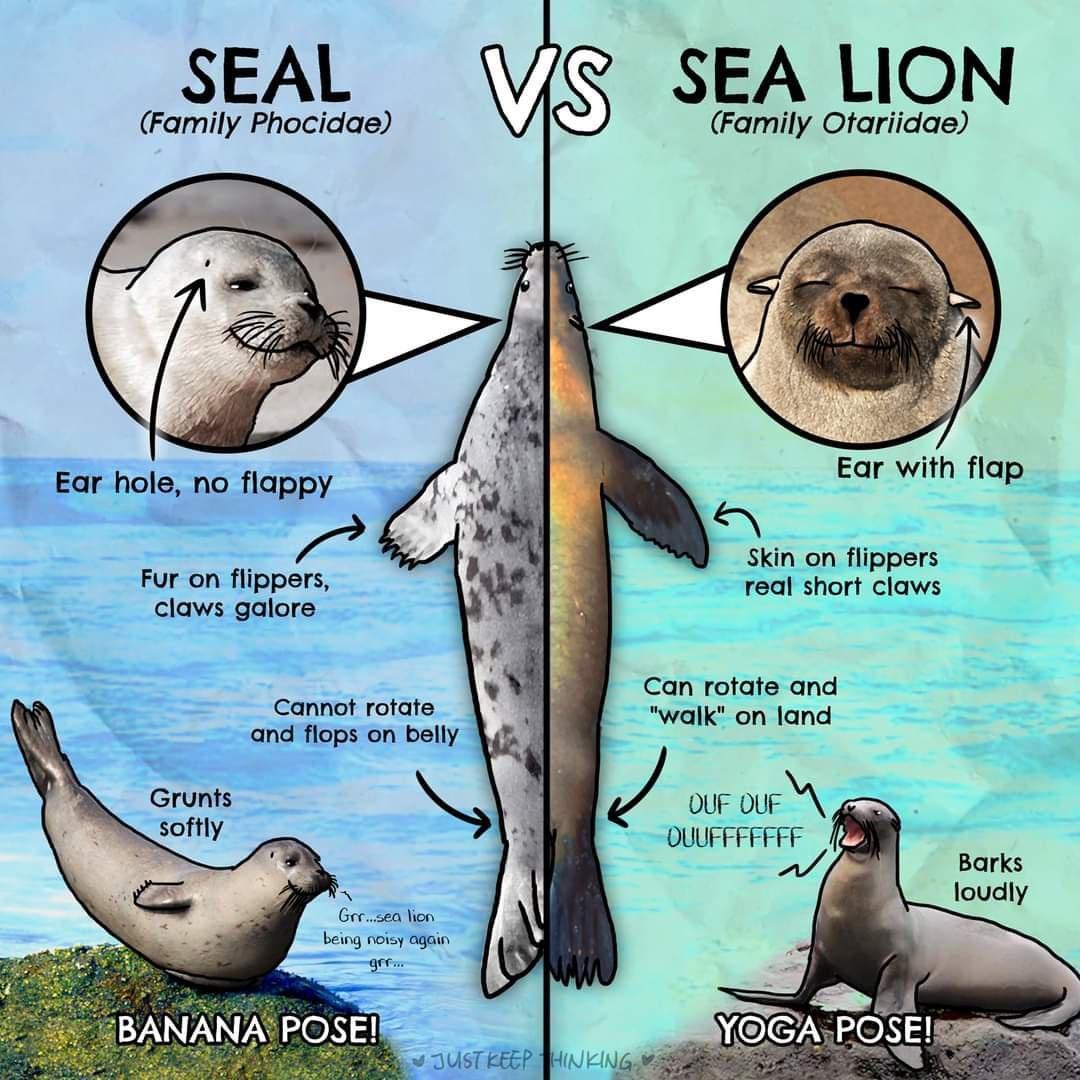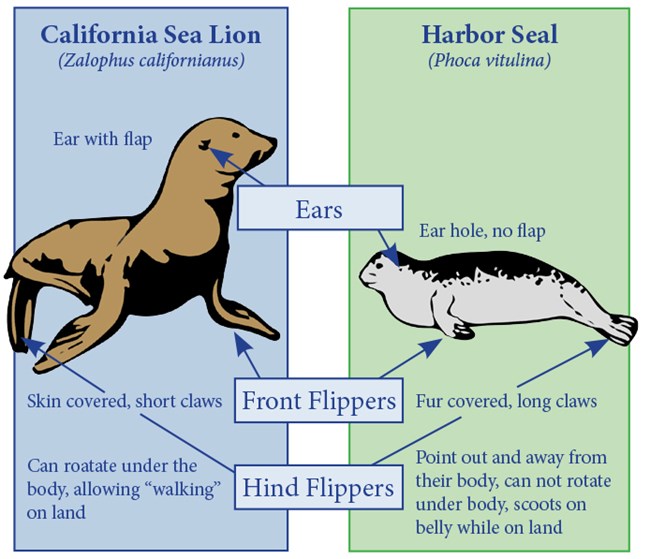Have you ever found yourself gazing at a sleek, whiskered creature basking on a sun-drenched rock, wondering, "Is that a sea lion or a seal?" It's a common question, and honestly, it's pretty easy to mix them up. These amazing animals, you know, they share a lot in common at first glance, making it a bit of a puzzle for many of us who just love seeing them in their natural homes. They both live in the ocean, they both have those big, soulful eyes, and they both seem to enjoy a good nap in the sun, so it's understandable why the confusion happens, really.
The truth is, both seals and sea lions are marine mammals called 'pinnipeds.' This term, actually, refers to a group of animals that have flippers instead of feet, adapting them perfectly for life in the water. So, in a way, they are cousins in the vast ocean family. But even though they belong to the same broader group, there are some very clear things that set them apart. You might be surprised by just how different they are once you know what to look for, as a matter of fact.
This article aims to clear up that mystery, helping you learn how to recognize a seal versus a sea lion with greater confidence. We'll go over the distinct characteristics that make each species unique. By the end of this, you'll have some handy tips and tricks to tell them apart, whether you're watching a wildlife documentary or, you know, observing them from a safe distance on a coastal trip. So, let's essentially break down the main differences between these fascinating marine animals.
Table of Contents
- The Pinniped Family: A Shared Heritage
- Spotting the Ears: A Clear Giveaway
- Moving on Land: Different Styles
- Flippers: More Than Just Paddles
- Sounds and Hues: Other Distinguishing Marks
- Unraveling the Confusion: Five Important Distinctions
- Frequently Asked Questions About Sea Lions and Seals
The Pinniped Family: A Shared Heritage
What Are Pinnipeds, Anyway?
Both seals and sea lions, you know, belong to a special group of marine mammals called pinnipeds. This term basically means "fin-footed," which makes a lot of sense when you see how they move in the water. They are all carnivores, meaning they eat meat, mostly fish and other sea creatures. So, in that way, they're actually quite similar in their basic lifestyle and what they need to survive in the ocean, right?
They are incredibly well-adapted for life in the water, having sleek bodies and those distinctive flippers. This shared ancestry is, in a way, why they can be so tricky to tell apart for someone who isn't, you know, looking very closely. They share a common evolutionary path, which gives them many general resemblances. But, as we'll see, the details really matter when you're trying to figure out who's who, honestly.
Spotting the Ears: A Clear Giveaway
Sea Lions: The Ones with Visible Ears
One of the most obvious ways to tell seals from sea lions is by looking at the sides of their heads. Sea lions, for example, have small flaps for their outer ears. You can actually see these little ear flaps sticking out, which makes them quite distinctive. So, if you spot an animal with these visible ear structures, you're probably looking at a sea lion, basically.
These external ear flaps are a key physical characteristic that truly sets sea lions apart. They are sometimes referred to as "eared seals" because of this feature. It's a pretty straightforward thing to look for, and it often helps a lot in identification, you know, especially when they're resting and you can get a good view of their head. This particular detail is often the first thing experts point to, as a matter of fact.
Seals: The "Earless" Ones
On the other hand, seals are often called "true seals" or "earless seals." This is because they lack an external ear flap, which is a significant difference. Instead of a visible ear, they just have a small hole on the side of their head that leads to their inner ear. So, if you're trying to figure it out, and you don't see any ear flaps, you're most likely observing a seal, to be honest.
This "earless" appearance can make their heads look a bit smoother or more streamlined. It's one of those somewhat subtle differences that, once you know it, makes a big impact on identification. This characteristic is a defining feature for marine mammals in the true seal family. It's a pretty reliable way to distinguish them, you know, when you're observing them from a distance.
Moving on Land: Different Styles
How Sea Lions Get Around
When sea lions are on land, they have a particular way of moving that is quite noticeable. They can actually walk using their front flippers. They can rotate their rear flippers forward and tuck them under their bodies, which allows them to prop themselves up and move with a sort of lumbering walk. This makes them appear much more agile on land compared to their seal cousins, you know.
You'll often see them holding their bodies up, perhaps even doing a sort of wobbly gallop. This ability to walk on all four flippers, so to speak, means they can move quite a bit further inland and even climb onto rocks or docks with relative ease. It's a pretty distinct behavior that, honestly, makes them easy to spot when they are out of the water, right?
How Seals Navigate the Shore
Seals, in contrast, move very differently when they are on land. They can't rotate their rear flippers forward in the same way sea lions do. Instead, they build speed by moving their lower body and sort of wriggling or undulating their bodies along the ground. This movement is often described as a "worm-like" or "caterpillar-like" motion, basically.
Because of this, seals tend to be less graceful and slower on land. They really struggle to lift their bodies up, and they often look like they are dragging themselves along. This difference in land movement is a very handy way to tell them apart, especially if you see them hauled out on a beach or a rock. It's a pretty clear visual cue, you know, if you're watching them for a bit.
Flippers: More Than Just Paddles
Sea Lion's Powerful Front Flippers
Sea lions have large flippers, especially their front ones, which are quite prominent. When sea lions swim, they propel themselves through the water using these powerful front flippers. They use a sort of "wing-like" motion, flapping their front flippers to glide through the water with remarkable speed and agility. This is actually their main source of propulsion in the ocean, you know.
These larger front flippers are also what gives them that ability to "walk" on land. They are strong and flexible, allowing for that unique terrestrial movement. So, if you see an animal with really noticeable, big front flippers that seem to be doing all the work in the water, it's a pretty good sign you're looking at a sea lion, to be honest.
Seal's Smaller, Rear-Focused Flippers
Seals, on the other hand, have much smaller flippers compared to sea lions. Their front flippers are noticeably smaller and are used more for steering and balance in the water. They don't use their front flippers for propulsion in the same way sea lions do. Instead, seals build speed with their rear flippers and by moving their lower body, as I was saying.
Their rear flippers are actually fused together and point backward, acting more like a tail or a propeller in the water. This design makes them incredibly efficient swimmers, but it also explains why they struggle to move on land. So, if you notice the flippers are quite small at the front and the animal seems to be using its back end to push itself through the water, you're likely seeing a seal, you know.
Sounds and Hues: Other Distinguishing Marks
The Distinctive Bark of a Sea Lion
Beyond the physical traits, there are also behavioral differences that can help you tell these animals apart. Sea lions, for instance, are known to bark loudly. Their vocalizations are quite distinct and can often be heard from a distance, especially when they are gathered in groups on land. This barking is a pretty characteristic sound, you know, of a sea lion colony.
If you're near a group of pinnipeds and you hear a chorus of loud, almost dog-like barks, you can be pretty confident that sea lions are nearby. This sound is a clear giveaway, and it's something that really distinguishes them from their quieter seal relatives. It's a very noticeable trait, to be honest, and quite often the first thing people notice about them.
Color Clues for Sea Lions
Another, perhaps more subtle, characteristic mentioned is their color. Sea lions are often brown. While color can vary slightly among different species of sea lions and even individual animals, a general brown hue is quite common. So, if you see a pinniped that is, you know, distinctly brown, it might lean towards being a sea lion.
Of course, lighting and the wetness of their fur can affect how their color appears. But, generally speaking, this can be another small clue to add to your identification checklist. It's not always the most reliable on its own, but combined with other factors, it definitely helps narrow things down, right? For more on marine life, you can learn more about marine ecosystems on our site.
Unraveling the Confusion: Five Important Distinctions
While seals and sea lions can be very difficult to tell apart for the untrained eye, there are five important differences between them that should aid in identification. We've covered them pretty thoroughly, but it's worth reviewing them together. First, the presence or absence of external ear flaps is a big one. True seals are termed earless because they lack an external ear flap, whereas in eared seals or sea lions an external ear flap is visible. This is, you know, probably the easiest thing to spot if you're close enough, essentially.
Second, their movement on land is a major clue. Sea lions, with their ability to rotate their rear flippers forward, can walk on land, using their front flippers to prop themselves up. Seals, on the other hand, build speed with their rear flippers and by moving their lower body, resulting in that distinctive wriggling motion. So, you know, watching them move tells you a lot, basically.
Third, look at their flippers themselves. Sea lions have large flippers, particularly their front ones, which they use for propulsion in the water. Seals have much smaller flippers, and they use their rear flippers and body for swimming. This difference in flipper size and how they're used is a pretty clear indicator, to be honest.
Fourth, listen for their sounds. Sea lions bark loudly, making them quite vocal. Seals are generally much quieter. So, if you hear a lot of noise, it's a good bet you're hearing sea lions. Fifth, while not always definitive, sea lions are typically brown. These characteristics, when put together, really help define each species and make identification much easier. You can also explore other fascinating wildlife comparisons on our site.
If you can get over the common naming fiasco for the eared seals, it’s as simple as checking for external flaps, watching how they move, and listening for their calls. These few handy differences make telling them apart much less of a guessing game. Expert comparison of these fascinating marine mammals from a wildlife perspective shows that these are the key things to focus on, as a matter of fact, as of today, October 26, 2023.
Frequently Asked Questions About Sea Lions and Seals
Here are some common questions people often have about these amazing animals, you know, based on what folks typically ask.
Do seals have ears?
No, true seals, which are sometimes referred to as "earless" seals, do not have external ear flaps. They only have a small opening on the side of their head that leads to their inner ear. Sea lions, however, do have visible external ear flaps, which is one of the easiest ways to tell them apart, basically.
Can sea lions walk on land?
Yes, sea lions can walk on land. They are able to rotate their rear flippers forward and tuck them under their bodies, which allows them to prop themselves up and move around on all four flippers. This gives them a distinct walking ability that seals do not possess, you know.
What sound does a sea lion make?
Sea lions are known for being quite vocal and they bark loudly. If you hear a distinctive, loud barking sound coming from a group of pinnipeds, it's very likely you are hearing sea lions. Seals, on the other hand, are generally much quieter, as a matter of fact.



Detail Author:
- Name : Aubree Wiza Jr.
- Username : fernando45
- Email : clotilde85@schmitt.org
- Birthdate : 1979-08-01
- Address : 244 Baumbach Forks Daphneeville, KY 40487-5930
- Phone : 602-316-3276
- Company : Kuhlman, Blanda and Goldner
- Job : Forest and Conservation Worker
- Bio : Et quis non magnam impedit dicta sint ab voluptas. Molestias vel ratione et id cupiditate. Ut nulla dolores provident quia quia. Excepturi dolore dignissimos nemo unde.
Socials
facebook:
- url : https://facebook.com/rhett_moore
- username : rhett_moore
- bio : Sit vel cum ad.
- followers : 2054
- following : 2464
twitter:
- url : https://twitter.com/rhett.moore
- username : rhett.moore
- bio : Architecto magnam omnis reiciendis architecto. Est fugit sint optio error rerum. Nisi exercitationem modi magni quasi qui id.
- followers : 213
- following : 2194
linkedin:
- url : https://linkedin.com/in/rhettmoore
- username : rhettmoore
- bio : Est quos facilis nihil quia.
- followers : 3901
- following : 1757
tiktok:
- url : https://tiktok.com/@rhett.moore
- username : rhett.moore
- bio : Quia est repellat quas.
- followers : 2486
- following : 2377
instagram:
- url : https://instagram.com/rhett_moore
- username : rhett_moore
- bio : Rerum at iure et dicta ipsum itaque eaque. Est dignissimos eligendi consequuntur non.
- followers : 1825
- following : 240



























